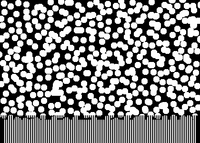Pore burner
A pore burner is a type of gas burner . With it, the combustion reaction of the premixed fuel - air mixture takes place in a porous structure and no longer in an open flame .
The result is a glowing foam with flameless, volumetric combustion (with volumetric combustion, the reaction takes place in a three-dimensional volume, in contrast to flat combustion, in which it takes place in a flame front with the interfaces fuel gas and oxygen). Since the free flame is not used technologically, there is no longer a conventional combustion chamber , but a reactor consisting of a large number of small reactors filled with ceramic foam or other structures. This opens up completely new design options for energy-related products with pore burner technology, such as linear or 3D-shaped burner units of any shape, e.g. B. thermal joining methods such as thermal welding method .
The pore burner consists of two zones, a exclusion zone with small pores and the larger reaction zone with larger-volume cavities. The narrow pores in the porous burner are chosen so that the mixture cannot ignite . It also serves as a flame arrester to prevent flashbacks and flashbacks in the event of low loads or low gas-air flows. The combustion is stabilized in the further reaction chamber. The good heat transport properties of the medium prevent the flame from lifting off with high loads or high gas-air flows. Therefore, the reaction zone is always on the contact surface between the two regions. Since the flame lift and the flashback are prevented, the output can be modulated over a wide range - by a factor of 20 . The result is a compact, low-emission combustion system with high power density and energy efficiency .
While conventional burner systems are characterized by inhomogeneous, flow-stabilized reaction zones with local temperature peaks and high emissions , pore burner technology allows homogeneous temperature ranges with a higher power density with greater dynamics and the use of gases with a low calorific value (such as landfill gas ).
The pore burner technology is an alternative to the conventional technology with a free flame. The advantage of the pore burner is that it allows a homogeneous and stable combustion process in a reactor , which significantly accelerates the combustion reaction. In addition, the use of suitable catalysts can lower the combustion temperature, which reduces the formation of nitrogen oxides and thus the thermal energy used for their reaction enthalpies can be saved and the energy efficiency increases slightly.
Areas of application
- Heating with a gas boiler and an oil boiler in combination with an evaporator
- Thermoprocess industry ( industrial furnaces , steel, non-ferrous metal production, glass and ceramic industry, thermoforming in the plastics industry)
- Online regeneration of diesel particulate filters ( DPF )
- Energy conversion for CHP and Stirling engines
literature
- Olaf Pickenäcker: Staged combustion in porous media. Shaker Verlag , Aachen 2001. ISBN 978-3-8265-9622-3 .
- Karin Pickenäcker: Low- emission, compact gas heating systems based on stabilized combustion in porous media. VDI-Verlag , 2001. ISBN 978-3-18-344506-6 .
- Stefan Diezinger: Multi-fuel burners based on pore burner technology for use in fuel cell systems. Shaker Verlag , Aachen 2001. ISBN 978-3-8322-5071-3 .
- Alexander Mach: Development of a compact heating system for EL heating oil based on combustion in porous ceramics. Shaker Verlag , Aachen 2008. ISBN 978-3-8322-7202-9 .
- Martin Steven: Modeling and numerical simulation of combustion processes in pore burners and soot filters. , Shaker Verlag , Aachen 2007. ISBN 978-3-8322-5071-3 .
Web links
- Innovation report
- Chair of Fluid Mechanics, Erlangen
- aybayfor research project
- Pore burners for industrial applications (PDF file; 828 kB)
- I-TPT handout pore burner (PDF file; 388 kB)
